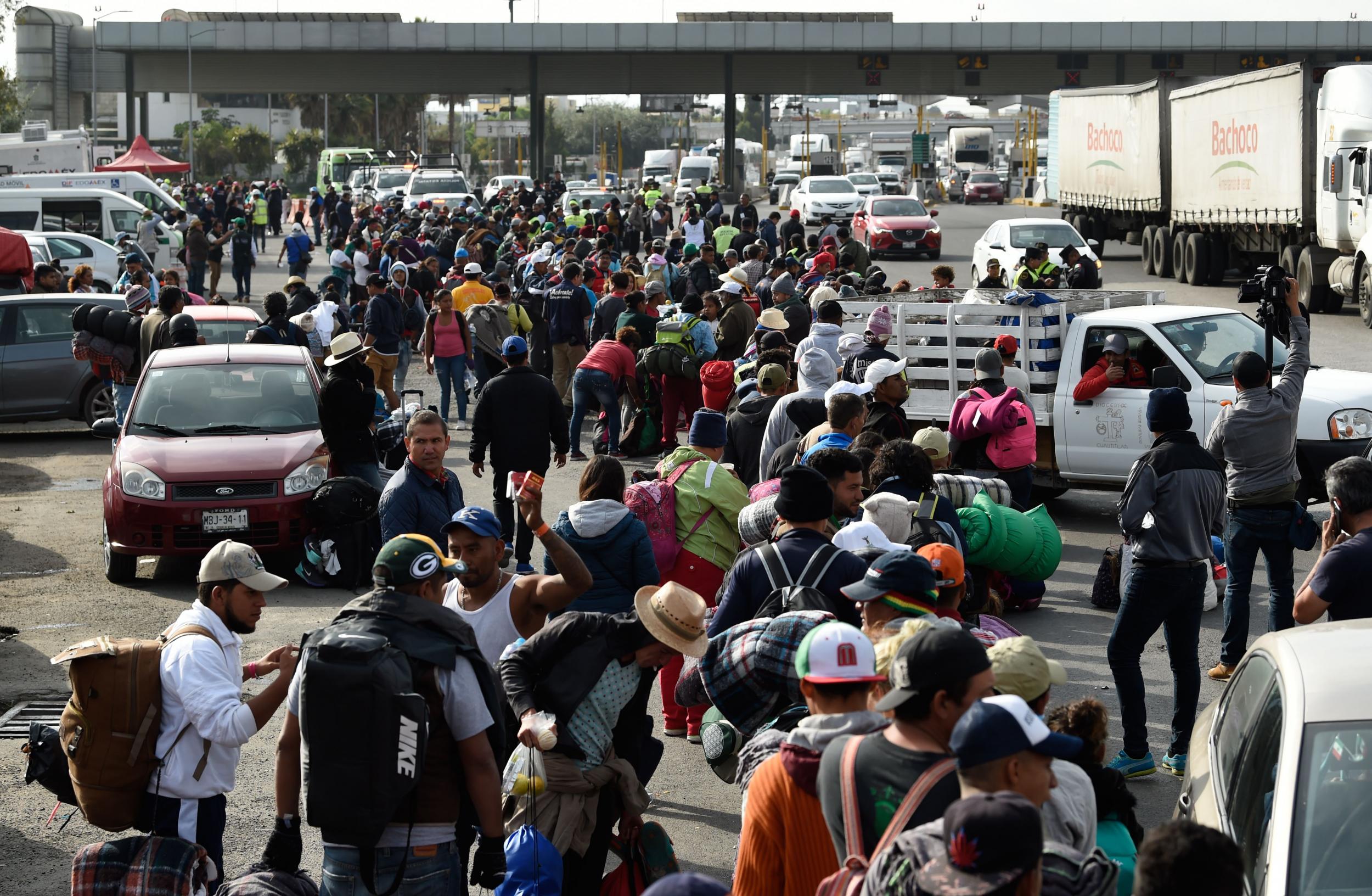Donald Trump's executive order to limit asylum being challenged in court
Migrant caravan in Mexico still several hundred miles from US border

President Donald Trump issued a proclamation to deny asylum to migrants who enter the country illegally as caravans of Central American migrants slowly approach the US-Mexico border.
The plan was immediately challenged in court by the American Civil Liberties Union (ACLU) and other legal groups who swiftly sued in federal court in Northern California, generally seen as a liberal federal court district.
“The arrival of large numbers ... will contribute to the overloading of our immigration and asylum system and to the release of thousands ... into the interior of the United States,” Mr Trump said in the proclamation, calling it a crisis.
The new regulations are intended to circumvent current US law which states individuals fleeing violence or persecution must enter the country in order to apply for the protected status.
About 70,000 people per year who enter the country illegally claim asylum.
“We need people in our country, but they have to come in legally,” Mr Trump said ahead of a trip to Paris for ceremonies to mark the 100th anniversary of the end of the First World War.
Migrants who cross illegally have been arrested but in the past were released and monitored as they awaited court hearings to determine their eligibility for asylum.
“The president is simply trying to run roughshod over Congress’s decision to provide asylum to those in danger regardless of the manner of one’s entry,” ACLU attorney Lee Gelernt told the Associated Press.
The litigation also seeks to put the new rules on hold while the case progresses.
The regulations in Mr Trump’s executive order go into effect 10 November 2018.
They would be in place for at least three months but could be extended, and don’t affect people already in the country.
The Department of Justice, which has a new chief in Acting Attorney General Matthew Whitaker, said in a statement the regulations were lawful.
Mr Trump’s announcement was the latest push to enforce a hard-line stance on immigration through regulatory changes and presidential orders, bypassing Congress, which has not passed any immigration law reform.
But, those efforts have been largely thwarted by legal challenges and, in the case of family separations this year, stymied by a global outcry that prompted Mr Trump to retreat.
The asylum law changes are meant to funnel migrants through official border crossings for speedy rulings instead of having them try to circumvent such crossings on the nearly 2,000-mile (3,200 km) border.
The US Border Patrol says it apprehended more than 50,000 people crossing illegally in October 2018, setting a new high this year. However, overall, illegal crossings are well below historical highs from previous decades.
Busy ports of entry already have long lines and waits, forcing immigration officials to tell some migrants to turn around and come back to make their claims. Backlogs have become especially bad in recent months at crossings in California, Arizona, and Texas, with some people waiting five weeks to try to claim asylum at San Diego’s main crossing.
Undocumented immigration across the US-Mexico border
Show all 14Administration officials said those denied asylum under the proclamation may be eligible for similar forms of protection if they fear returning to their countries, though they would be subject to a tougher threshold.
Those forms of protection include “withholding of removal” — which is similar to asylum, but does not allow for green cards or bringing families — or protection under the United Nations Convention Against Torture.
US Department of Homeland Security officials said they were adding staffing at the border crossings to manage the expected crush, but it’s not clear how migrants with families, would be held as their cases are adjudicated.
Family detention centers are largely at capacity and Mr Trump has said he wanted to erect “tent cities,” but nothing has been funded after the massive outcry over the administration’s family separation policy earlier this year.
Because children are not allowed to enter the US criminal justice system, parents or guardians were detained for illegally entering the country and more than 2,000 children were housed in separate detention centres until another executive order ending the policy.
The US is also working with Mexico in an effort to send some migrants back across the border. Right now, laws allow only Mexican nationals to be swiftly returned and increasingly those claiming asylum are from the Central American countries of Honduras, El Salvador and Guatemala where gang violence is rampant.
Mr Trump pushed immigration issues hard in the days leading up to 6 November midterm elections, railing against the caravans which were still 1,000 miles from the border.
At various times he referred to them as “criminals” and groups which contain “unknown Middle Easterners”.
He has made little mention of the issue since the election, but has deployed more than 5,600 US troops deployed to the border mission, with about 550 actually working on the border in Texas.
Mr Trump also suggested he would revoke the right to citizenship for babies born to non-US citizens on American soil in an attempt to stop “chain migration,” or those entering the country and bringing family members to come be with them later.
There has been no executive order issued on that as yet, but the president has said: “We’re signing it. We’re doing it”.
Mr Trump invoked the same powers he used last year to impose a travel ban on travellers from Muslim-majority countries Iran, Somalia, Libya, Yemen, and Syria as well as Venezuela and North Korea.
After several challenges from federal courts, it was upheld by the Supreme Court earlier in the year.
Agencies contributed to this report
Subscribe to Independent Premium to bookmark this article
Want to bookmark your favourite articles and stories to read or reference later? Start your Independent Premium subscription today.

Join our commenting forum
Join thought-provoking conversations, follow other Independent readers and see their replies